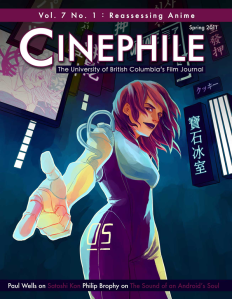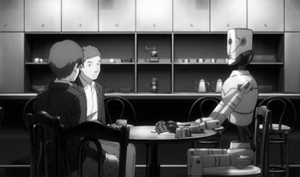The University of British Columbia’s Spring 2011 edition of Cinephile is now available online. Comprised of six articles under the theme “Reassessing Anime,” the issue aims to explore some of the “overlooked aspects of anime” in response to the art form’s “increasing presence and influence on Western art, literature and film” (Cannon, 2011: 2). And indeed, the journal does proffer insightful analyses on topics that are timely yet strangely neglected. While I do not intend to “review” each individual article in the publication, I will dip into two that I found to be particularly interesting on the topics of moe and music.
 Not surprisingly, it is an academic with a keen interest in otaku community and otaku identity that is the one to tackle the moe phenomenon. Scholar Michael R. Bowman’s very necessary article, “Beyond maids and Meganekko: Examining the Moe Phenomenon” (Bowman, 2011: 14-18), offers some much needed clarity on the concept. Bowman attempts to pin down a definition of what moe actually is, untangling it from the slew of contradictory and sexually-based misconceptions rife in the cyber community. He claims that it is in fact “nonsexual” where any “[s]exual feeling should be seen only as a secondary response that sometimes is coupled with, but is still separate from, the more authentic moe response…” (Bowman, 2011: 15). Furthermore he explores moe as a “longing for fatherhood,” a nurturing, rather than a perverse, lecherous and depraved, response (Bowman, 2011: 16). For Bowman, moe becomes a manifestation of kawaii, a masculine escape from the numbing realities of adulthood in Japan, a prolongation of childhood (Bowman, 2011: 17). Also examined are moe’s origins, expelling myths of it being a modern phenomenon (Bowman, 2011: 16). While Bowman’s article was not what drew me to the journal, it soon revealed itself as the most relevant and important piece in regards to the current anime/otaku climate. I highly recommend it to those with an interest in moe, especially those intending to write about it.
Not surprisingly, it is an academic with a keen interest in otaku community and otaku identity that is the one to tackle the moe phenomenon. Scholar Michael R. Bowman’s very necessary article, “Beyond maids and Meganekko: Examining the Moe Phenomenon” (Bowman, 2011: 14-18), offers some much needed clarity on the concept. Bowman attempts to pin down a definition of what moe actually is, untangling it from the slew of contradictory and sexually-based misconceptions rife in the cyber community. He claims that it is in fact “nonsexual” where any “[s]exual feeling should be seen only as a secondary response that sometimes is coupled with, but is still separate from, the more authentic moe response…” (Bowman, 2011: 15). Furthermore he explores moe as a “longing for fatherhood,” a nurturing, rather than a perverse, lecherous and depraved, response (Bowman, 2011: 16). For Bowman, moe becomes a manifestation of kawaii, a masculine escape from the numbing realities of adulthood in Japan, a prolongation of childhood (Bowman, 2011: 17). Also examined are moe’s origins, expelling myths of it being a modern phenomenon (Bowman, 2011: 16). While Bowman’s article was not what drew me to the journal, it soon revealed itself as the most relevant and important piece in regards to the current anime/otaku climate. I highly recommend it to those with an interest in moe, especially those intending to write about it.
More in theme with this blog, renowned, Australian-based writer Philip Brophy’s piece “The Sound of an Android’s Soul: Music, Muzak and MIDI in Time of Eve” (Brophy, 2011: 9-13) unites my interests of anime, music and technology. The article opens with a description of a scene from Time of Eve (Yoshiura, 2008-9) in which Rikuo decides to give up his aspirations of being a concert pianist after an android performs a piece of music that was not only technical perfect, but that actually emotionally moved him. This opens up a new dramatic and existential space in which humans and androids can “reflect upon and ultimately come to terms with how they as individuals relate to the social complexion of their emotional contrasts with each other” (Brophy, 2011: 10). This theoretical space sent my mind into an excited frenzy. There is vast potential here to marry my previous ontological studies/writings on EDM with more existential and dramatic possibilities and becomings; a heuristic springboard into a comparison of man making machine music (e.g. techno) and machines making their own potentially “organic” music. Stereotypically machine music is soulless and “cold” as oppose to the “warmer” sounds of the organic, of nature (e.g. the voice) (Marsh & West, 2003: 183). The space such a discussion opens up is one of flux, a place where such structuralist constructs and limiting binaries are transgressed.[1] My inner Deleuzian salivates at the lines of flight proffered by Mr. Brophy – pure potential, cyborgian becomings, the overhaul of posthuman identity, the subsequent emotional interactions, a new plane of thought from which to spring forth – it’s the motherfucking Dogon egg!
Oh my. Excuse me.
These are just two of the articles that stood out for me. If you are interested in being at the forefront of anime academia, I suggest going here and feeding your brain with some timely and nutritious anime-focused literature. After all, “It is [an] intersection between globalisation, popular culture and fandom, which makes anime a fascinating subject of cultural analysis” (Leong, 2011: 19). Cinephile’s “Reassessing Anime” understands this, energising anime’s scholarly snowball to grow and continue to gather momentum. Publications like this keep the field invigorated and forward thinking and are, I believe, well worth your time. Check it out.
[1] Marsh & West’s discussion is specifically gender focused, looking at how electronic music works at breaking down the masculine-feminine dichotomy. However I think it also works in making a point about the nature of existence and the betwixt and between space of human-machine coexistence and increasing likeness.
B4XC3K4JSV2U



May 23rd, 2012 at 7:59 am
… [Trackback]…
[…] Read More: technoorient.wordpress.com/2012/05/21/cinephile-reassessing-anime/ […]…
May 24th, 2012 at 12:22 am
[…] Reassessing Anime […]
February 23rd, 2013 at 10:12 pm
I’ll have to check this out! Nice post 🙂
By the way, I have my own blog which focuses on Asian culture and entertainment such as video games and I wonder if it is possible for you to view it and tell me what you think please: http://nynyonlinex.wordpress.com
February 26th, 2013 at 3:57 am
Yeah sure. I’ll have a read sometime this week. Glad to see my blog is still getting some comments despite its status of extended hiatus 🙂
February 26th, 2013 at 9:58 am
You should post more, it’s always great too 🙂
February 26th, 2013 at 9:50 pm
Time is my enemy 😦
February 26th, 2013 at 10:33 pm
Aw I know how you feel. Less time to do anything 😦
I know how you feel. Less time to do anything 😦